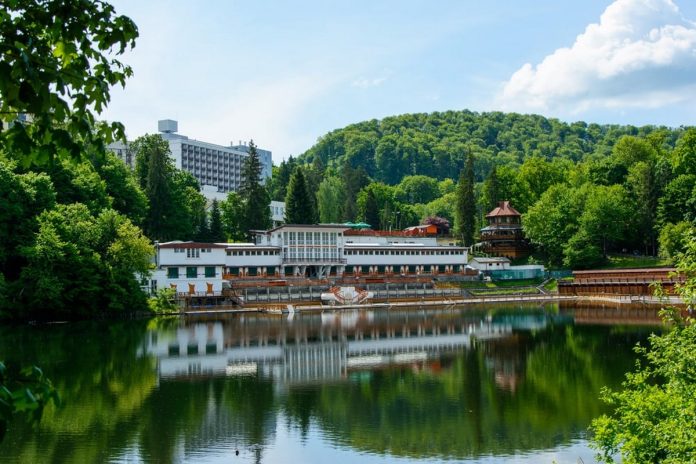Cluj Napoca-born biophysicist and scientific research diver Dr. Peter Hantz, a visiting lecturer and research associate at Hungary’s Eötvös Loránd University – Organic Chemistry Department, and Janos Fulop-Nagy, the CEO of the Ensana Health Spa Hotels group in Sovata, unveiled on Wednesday a one-off exhibition about life in the depths of Sovata’s Ursu (Bear) Lake, the largest heliothermal lake in the world (4,200 sqm), and also one of the most hypersaline water bodies on the planet, write Agerpres.
„Until recently, we could only imagine what life could be like and what forms it could take at 15, 16 or 18 meters deep under water, but now we can see and compare them with what we have imagined so far. We want tourists to know what is happening in this lake. Much has been written and said about it, everyone knows it’s beneficial for human health, but now there are also pictures to show how Mother Nature works to create the mud and this salty, warm water that helps with the treatment procedures applied in Sovata spa,” Janos Fulop-Nagy told a press conference.
Peter Hantz, who took the photos during the research dives carried out in the depths of Ursu Lake, believes that tourists should learn how the heliothermic phenomenon works and what life forms exist in a lake with such a high salt content, captioning the photographs with rigorous explanations in Romanian, Hungarian and English.
„What is the halocline layer? It is that layer where the salt concentration increases suddenly as we descend deeper, here the halocline layer is responsible for the heliothermal heating,” Dr. Hantz Peter pointed out.
According to the explanations in the exhibition, Ursu Lake is not artificially heated and there is no geothermal or post-volcanic activity in it or around it, and the warm water layer located between 2 and 3 meters deep and which sometimes exceeds 40 °C is exclusively the result of solar radiation, i.e. of the heliothermic phenomenon.
The lake’s salinity is attributable to the fact that in the area surrounding the city of Sovata, known as the Salt Region, the soil hides salt rocks in many places, and the lake’s cavity was formed by the dissolution of such salt rocks; also, the lake is fed by a salty stream.
As for life forms in the lake, the researcher showed that there are no fish, but only brine shrimp (Artemia salina), and only in the water above the halocline layer, in the region less than 2.7 meters deep.
„Even in the least saline layers, close to the surface of the lake, the world’s most halophilic fish species, which is not even indigenous to Europe, would barely survive. Below the halocline layer there is no oxygen and hydrogen sulphide concentrations are very high, therefore no higher organisms can be found,” explained Peter Hantz.
He pointed out that the lake’s salty water is clean and the water body is well maintained and, being a natural lake, it cannot be drained but neither needs draining, as its ecosystem cleans it naturally.
Tourists can also learn from the exhibition that in the early 1900s, Lake Ursu was called Lake Illyés after the name of its former owner, and the current name came in use around 1910, because the shape of the lake resembles a bear skin.




